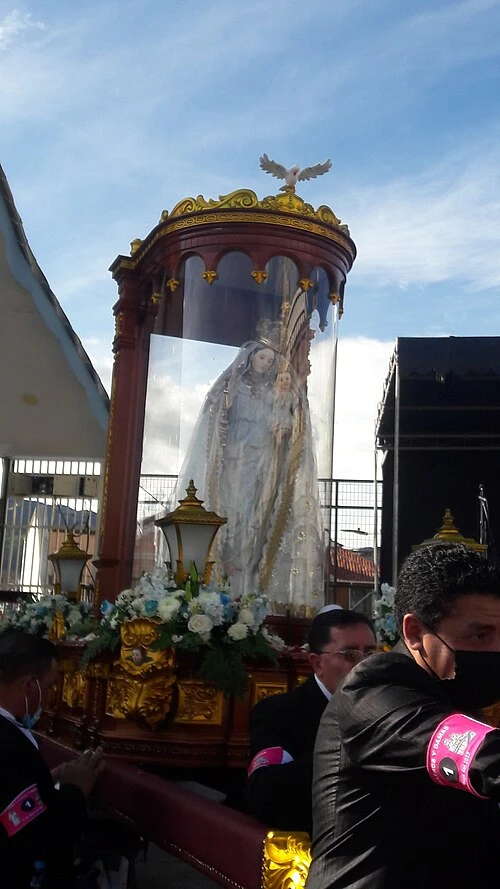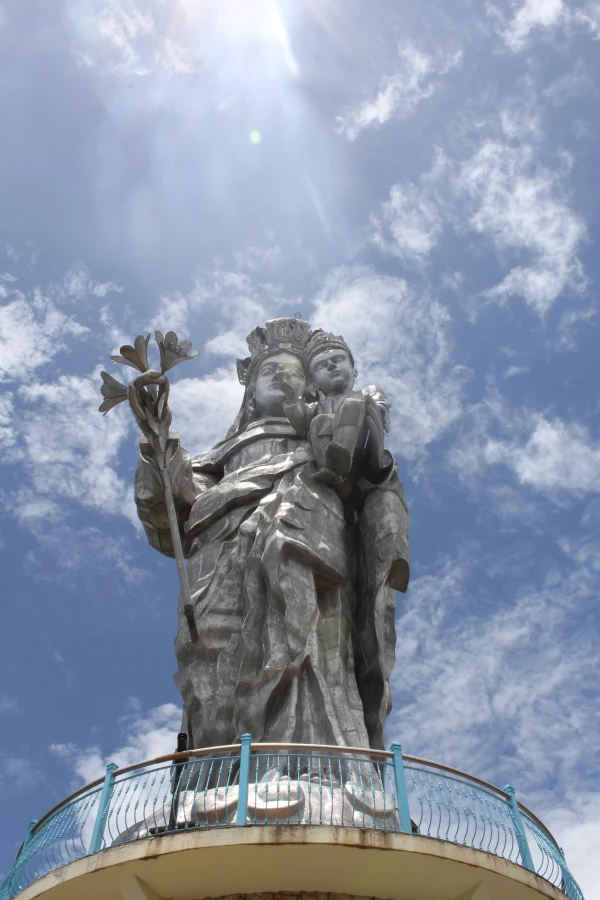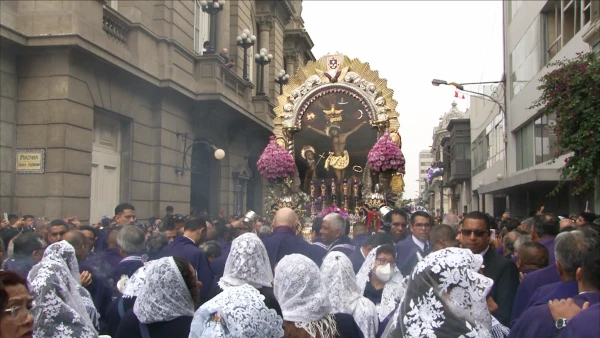The Lord of Miracles goes out in procession this weekend in Lima, the capital of Peru, in this month of October dedicated to Him.
The love that the faithful have for Cristo Moreno, as this distinctive symbol of Peru is also known in the world, is reflected in the crowds that accompany him and who ask him for favors and hope in the face of the current tense situation in the country. What few know about the beloved Christ of Pachacamilla is who the Virgin of the Cloud is, the Marian dedication that is behind her on the same litter, the platform that carries both.
Receive the main news from ACI Prensa by WhatsApp and Telegram
It is increasingly difficult to see Catholic news on social media. Subscribe to our free channels today:
Who is the Virgin of the Cloud?
The devotion to the Virgin of the Cloud has its origin in the 17th century in Quito, Ecuador, when a group of faithful went in procession praying for the health of Bishop Sancho de Andrade y Figueroa. It was then that some saw the Mother of God on a cloud, which began her cult.

“On December 30, 1696, while they were in a procession, some perceived that there was an image of the Virgin on a cloud. She had a crown on her head and a lily in her hand, which is what the current representation looks like,” Mons. Pedro Díaz Hidalgo, author of the book, explains to ACI Prensa.A month with the Lord of Miracles” and knowledgeable about its history.
“They saw that the image of the Virgin was carrying the Child Jesus on her left arm. According to canon Pedro Zumárraga, who tells the story, the apparition lasted more or less ‘the time of an Our Father, a Hail Mary and a Glory Be’. From there the bishop was cured and this invocation of the Virgin of the Cloud arose,” details the expert who has been spiritual director of the Brotherhood of the Lord of Miracles. of Nazarenas for twelve years.
The main image of this dedication is in the sanctuary built in his honor in the Azogues canton, in the Ecuadorian province of Cañar.

Why is the Virgin of the Cloud behind the Lord of Miracles?
“The writer José Eusebio de Llanos Zapata, an 18th century chronicler, says that in October 1747, a year after the strong earthquake in Lima on October 28, 1746, the procession left like every year, but this time accompanied by the image of the Virgin of the Cloud,” says Mons. Pedro Hidalgo.
“There is no certainty, but rather a quite valid hypothesis, that the image of the Virgin of the Cloud has been placed as a tribute to Sister Antonia Lucía del Espíritu Santo – a woman from Guayaquil whose name before becoming a nun was Antonia Maldonado – who founded the Nazarene Institute with which something that she could not see in life began: the monastery of Nazarenas Carmelitas Descalzas, since she wanted a monastery according to the rule of Santa Teresa”, he adds.
The Virgin of the Cloud “was then placed in homage to Sister Antonia Lucía del Espíritu Santo, who died about 40 years before the Marian image with the Lord of Miracles went out in procession,” highlighted the priest.

Mons. Pedro Hidalgo also said that, currently, in the Church of Las Nazarenas, where the image of the Lord of Miracles is preserved, the Virgin of the Cloud is remembered “with a triduum on October 29, 30 and 31; and in some churches on December 30, the date on which she appeared in Ecuador”, although her cult in Peru is still incipient, despite being the companion of the Purple Christ.
The expert also specified that this Marian devotion “is directly related to the Lord of Miracles. I dare say that around 95% of the more than 400 brotherhoods in the world carry the Virgin of the Cloud behind the Moreno Christ.”
Is the Virgin of the Cloud as miraculous as the Lord of Miracles?
“The image is not the miraculous one,” says the priest. “The one who performs miracles is the Lord, it is God, although it is true that these graces, favors or miracles are requested, sometimes through the intercession of the Virgin or the mediation of the image of the Lord of Miracles.”
However, he continues, “through the Virgin of the Cloud graces and favors are granted because obviously there are people, there are faithful who invoke the Virgin and have obtained graces, but without a doubt the number of people who have obtained graces and favors through the invocation of the Lord of Miracles is greater.”
Who is the Lord of Miracles?
The Lord of Miracles, also called Cristo de Pachacamilla, Cristo Morado or Cristo Moreno is an image of Jesus painted on an adobe wall by an Angolan slave and preserved in the Sanctuary of Las Nazarenas in Lima.
The miraculous image has withstood the onslaught of several earthquakes, which is why its veneration has grown more and more since the 17th century, becoming a distinctive feature of Peruvians throughout the world, also in Rome, where every October it reaches St. Peter’s Square in the Vatican.
This 2025, the procession of the Lord of Miracles will arrive with more than 4,000 people and will be present at the canonization Mass in which Pope Leo XIV will elevate seven new saints to the altars on Sunday, October 19. The Holy Father, who was Bishop of Chiclayo in northern Peru, will address his long-awaited greeting to the Peruvian faithful.

